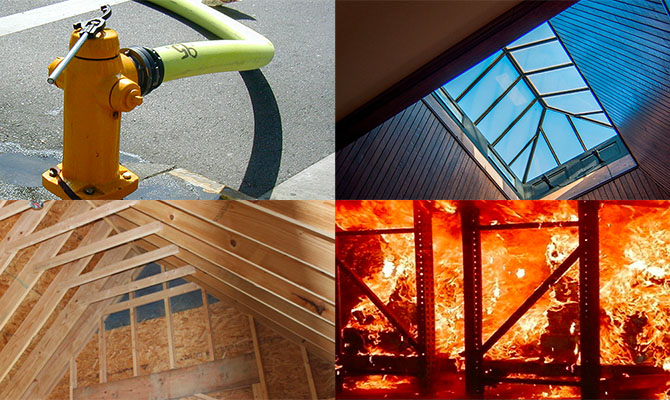Certificates will comply with CAL FIRE CEU requirements for CAL FIRE approved training courses per Title 19. Fire Smarts is a CAL FIRE approved provider for this training course which may be used towards California certified sprinkler fitter continuing education requirements that include completing 30 hours every three years to maintain the state certification (Section 946). CAL FIRE CEU’s are assigned based on 0.1 CEU per training contact hour. Learn more about CAL FIRE licenses and registration at https://osfm.fire.ca.gov/govmotus-fire
Course Description: This 10-hour course is based on the California adopted edition of NFPA 13 ‘Standard for the Installation of Sprinkler Systems’ and covers evaluating the water supply available for the fire sprinkler system and hydraulic calculations. This includes discussing the common formulas for hydraulics and how they are applied to tree, loop and grid systems. Ceiling pockets and sloped ceiling will also be discussed along with the use of full-scale fire testing for performance-based fire sprinkler systems.
Course Modules:
Module 1 – Fire Hydrant Flow Testing and Evaluating Water Supply – 1.5hrs
A key step in fire sprinkler design is to evaluate the available water supply needed to complete hydraulic calculations of water-based fire protection systems. This module will provide in-depth coverage of conducting hydrant flow testing based on NFPA 291 ‘Recommended Practice for Fire Flow Testing and Marking of Hydrants’. Specific emphasis will be given to the need of assessing the reliability of flow test data relative to the potential operating variations in the public utility along with a discussion on the common variables which should be considered. An evaluation process of the collected flow test data will be presented to demonstrate how to assess the need for the installation of a fire pump, water storage tank, break tank, etc.
Module 2 – Hydraulic Calculations Basic Formulas – 1.5hrs
This module will begin with a brief review of the two most common design approaches—area/density and specific application. The formulas associated with each approach will be covered including those for determining sprinkler flow, pressure, and K-factors. The interaction between the formulas will be demonstrated along with how to determine the most efficient system performance including sprinkler type, area of coverage, and orifice size (K-factor). Participants will learn how to use the Hazen-Williams formula along with the impact on hydraulics from pipe type, size, and layout. Formulas for determining equivalent lengths for pipe fittings will also be examined.
Module 3 – Hydraulic Calculations for Tree Systems – 1.5hrs
This module builds upon the Hydraulic Calculations Basic Formulas module to demonstrate conducting hydraulic calculations for a simple tree system. The exercise will include the determination of the required end head pressure, calculation of friction loss using the Hazen Williams formula, inclusion of appropriate fitting equivalent lengths, and the use of equivalent K factors and balancing pressure for a combination of sprinklers and piping. The proper use of hydraulic calculation forms for conducting such calculations will be presented. Finally, a comparison of the calculated demand will be made with the available water supply to demonstrate adequacy of the design.
Module 4 – Hydraulic Calculations for Looped Systems – 1.5hrs
This module builds upon the ‘Hydraulic Calculations Basic Formulas’ and ‘Hydraulic Calculations for Tree Systems’ modules to cover more advanced calculation methods used for looped and gridded systems. This presentation will also discuss velocity pressure calculations and the Darcy-Weisbach formula for friction loss calculation using the Moody diagram. Participants will go through an exercise to demonstrate the concepts involved in these calculation methods and to provide a high-level understanding of their appropriate use in fire sprinkler design.
Module 5 – Sprinkler Protection for Ceiling Pockets, Clouds and Skylights – 1.5hrs
The use of ceiling pockets, ceiling clouds and skylights are increasingly seen in architectural design for commercial facilities. This module focuses on fire sprinkler system design considerations for protecting these elements using standard spray sprinklers. Based on NFPA 13 ‘Standard for the Installation of Sprinkler Systems’, the presenter will discuss where fire sprinkler protection is required as well as sprinkler layout spacing rules for properly protecting these building elements.
Module 6 – Sprinkler Layout and Positioning Under Flat and Sloped Ceilings – 1.5hrs
This module discusses the rules for layout and positioning of fire sprinklers under both flat and sloped ceilings based on NFPA 13 ‘Standard for the Installation of Sprinkler Systems’. Participants will learn the method of calculation for the coverage area per sprinkler along with discussion on how to apply this with maximum allowable coverage area and hydraulic design calculations. A review of the criteria for the allowable coverage area based on the specific occupancy, ceiling construction configuration and type of sprinkler utilized will be presented. Finally, the presenter will discuss the required position and orientation of the sprinkler deflector with respect to the deck above and storage.
Module 7 – Full-Scale Fire Testing for Performance-Based Fire Protection – 1hr
While most fire sprinkler systems are designed using the prescribed requirements found in NFPA 13, the standard allows for alternative arrangements as long as the level of safety is not lowered. Performance-Based is an option that can provide superior performance with a more desirable design. This module provides an overview of utilizing full-scale fire testing consistent with the NFPA standards for Performance-Based fire sprinkler design. Participants will review factors that should be considered and evaluated prior to starting a fire test program. The impact of selected criteria on fire testing will be covered along with the benefits of Performance-Based options. The presentation will also discuss the AHJ approval process and important considerations when using Performance-Based design.
Click Here to Register Online
Format: Instant Access Recorded Webinars
CEUs: Based on 10 contact hours of training (see CEUs tab for details)


